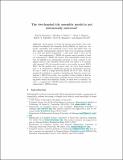| dc.contributor.author | Demaine, Erik D. | |
| dc.contributor.author | Patitz, Matthew J. | |
| dc.contributor.author | Rogers, Trent A. | |
| dc.contributor.author | Schweller, Robert T. | |
| dc.contributor.author | Summers, Scott M. | |
| dc.contributor.author | Woods, Damien | |
| dc.date.accessioned | 2014-04-17T18:49:39Z | |
| dc.date.available | 2014-04-17T18:49:39Z | |
| dc.date.issued | 2013-07 | |
| dc.identifier.isbn | 978-3-642-39205-4 | |
| dc.identifier.isbn | 978-3-642-39206-1 | |
| dc.identifier.issn | 0302-9743 | |
| dc.identifier.issn | 1611-3349 | |
| dc.identifier.uri | http://hdl.handle.net/1721.1/86205 | |
| dc.description.abstract | In this paper, we study the intrinsic universality of the well-studied Two-Handed Tile Assembly Model (2HAM), in which two “supertile” assemblies, each consisting of one or more unit-square tiles, can fuse together (self-assemble) whenever their total attachment strength is at least the global temperature τ. Our main result is that for all τ′ < τ, each temperature-τ′ 2HAM tile system cannot simulate at least one temperature-τ 2HAM tile system. This impossibility result proves that the 2HAM is not intrinsically universal, in stark contrast to the simpler abstract Tile Assembly Model which was shown to be intrinsically universal (The tile assembly model is intrinsically universal, FOCS 2012). On the positive side, we prove that, for every fixed temperature τ ≥ 2, temperature-τ 2HAM tile systems are intrinsically universal: for each τ there is a single universal 2HAM tile set U that, when appropriately initialized, is capable of simulating the behavior of any temperature τ 2HAM tile system. As a corollary of these results we find an infinite set of infinite hierarchies of 2HAM systems with strictly increasing power within each hierarchy. Finally, we show how to construct, for each τ, a temperature-τ 2HAM system that simultaneously simulates all temperature-τ 2HAM systems. | en_US |
| dc.language.iso | en_US | |
| dc.publisher | Wiley Blackwell | en_US |
| dc.relation.isversionof | http://dx.doi.org/10.1007/978-3-642-39206-1_34 | en_US |
| dc.rights | Creative Commons Attribution-Noncommercial-Share Alike | en_US |
| dc.rights.uri | http://creativecommons.org/licenses/by-nc-sa/4.0/ | en_US |
| dc.source | MIT web domain | en_US |
| dc.title | The Two-Handed Tile Assembly Model Is Not Intrinsically Universal | en_US |
| dc.type | Article | en_US |
| dc.identifier.citation | Demaine, Erik D., Matthew J. Patitz, Trent A. Rogers, Robert T. Schweller, Scott M. Summers, and Damien Woods. “The Two-Handed Tile Assembly Model Is Not Intrinsically Universal.” Lecture Notes in Computer Science (2013): 400–412. | en_US |
| dc.contributor.department | Massachusetts Institute of Technology. Computer Science and Artificial Intelligence Laboratory | en_US |
| dc.contributor.department | Massachusetts Institute of Technology. Department of Electrical Engineering and Computer Science | en_US |
| dc.contributor.mitauthor | Demaine, Erik D. | en_US |
| dc.relation.journal | Automata, Languages, and Programming | en_US |
| dc.eprint.version | Author's final manuscript | en_US |
| dc.type.uri | http://purl.org/eprint/type/ConferencePaper | en_US |
| eprint.status | http://purl.org/eprint/status/NonPeerReviewed | en_US |
| dspace.orderedauthors | Demaine, Erik D.; Patitz, Matthew J.; Rogers, Trent A.; Schweller, Robert T.; Summers, Scott M.; Woods, Damien | en_US |
| dc.identifier.orcid | https://orcid.org/0000-0003-3803-5703 | |
| mit.license | OPEN_ACCESS_POLICY | en_US |
| mit.metadata.status | Complete | |

